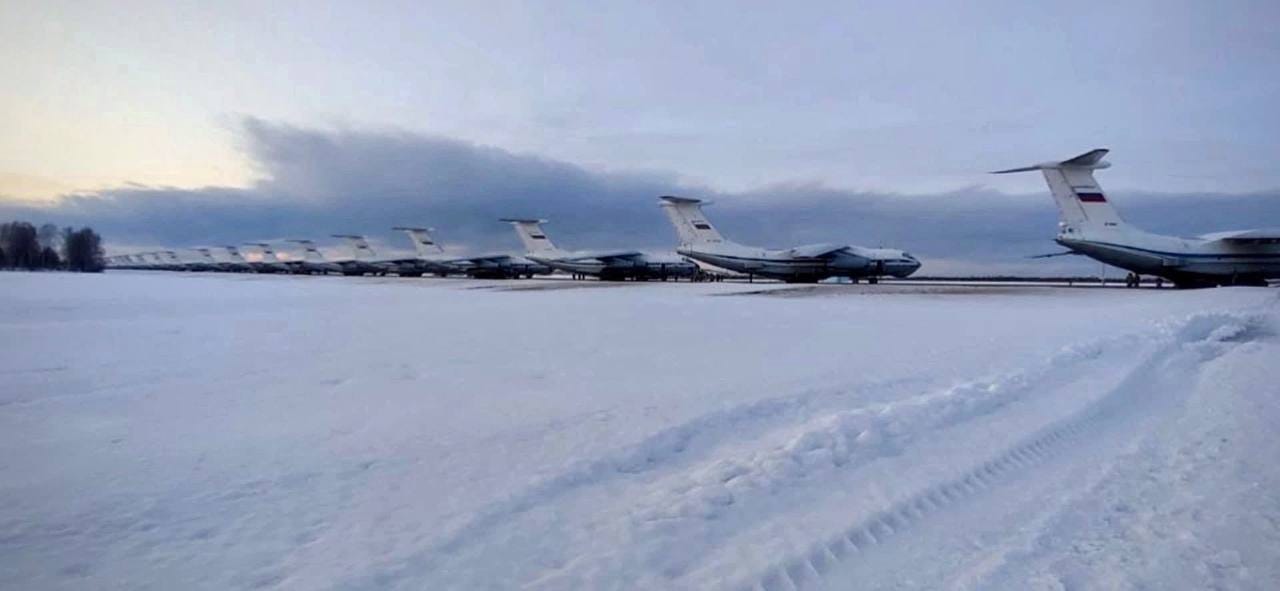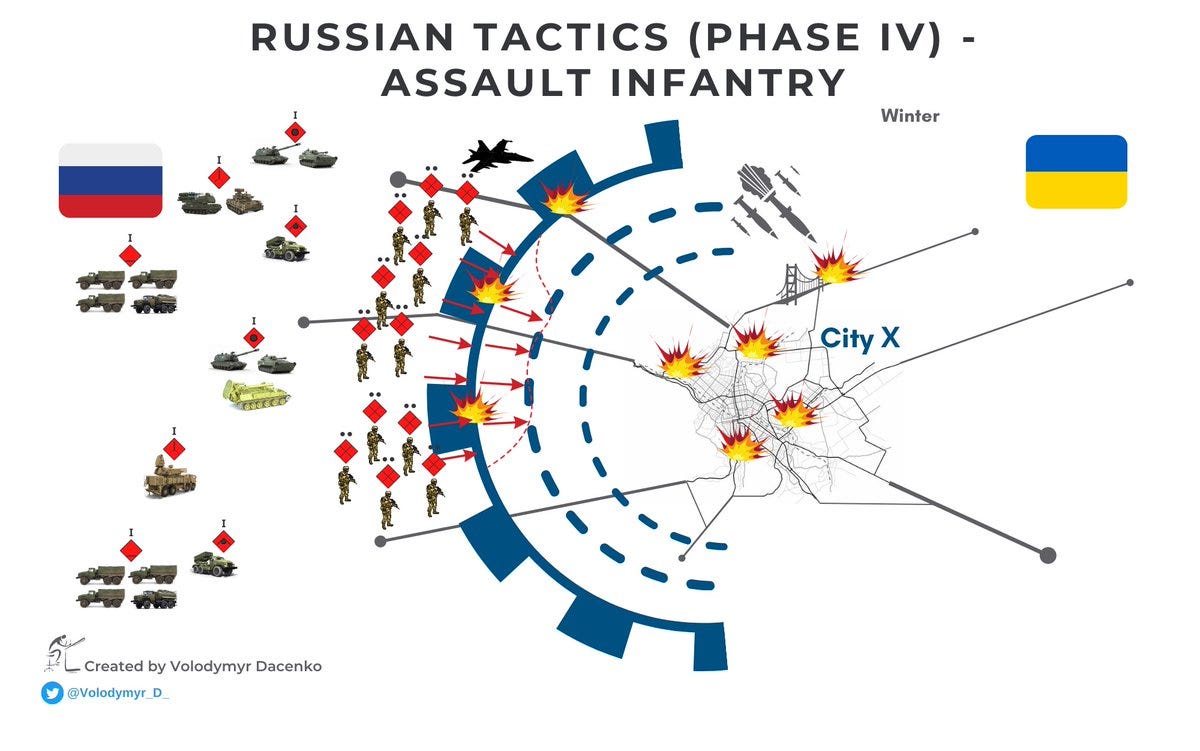Jan 29: Volodymyr Dacenko- How Russian tactics have changed
Thread published on January 24, 2023
Who is Volodymyr Dacenko…
Volodymyr Dacenko is an analyst, a columnist, and special reporter for Forbes Ukraine writing about military topics, and a member of the reform team of the SC "Ukroboronprom" (a group of state defense companies of Ukraine).



Phase I - Blitzkrieg
Initially, the Ru attack was planned as a large-scale rapid operation from the air, land and water. It was planned in 4 acts:
Act 1: A large-scale missile attack was supposed to suppress the Ukrainian air defense system and create chaos in defense management
Act 2: The main role was planned for amphibious operations. Which were to quickly capture key objects and capture government buildings in the main cities - Kyiv, Kharkiv and Odesa
Ru planned to use hundreds of helicopters, at least 18 large Il-76 planes and a naval landing force
To capture Kyiv, it was planned to land several hundred paratroopers on 24 Mi-8 transport helicopters accompanied by 10 Mi-24, Ka-52 combat helicopters and 12 fighter jets in Gostomel (airfield north of Kyiv).
Next, Gostomel was to become a base to receive large Il-76 transport planes carrying the main forces of the amphibious operation. In a matter of hours, Russian troops were to break into Kyiv and seize the main administrative buildings
Act 3: Large convoys of armored vehicles were to block off key cities from support and suppress resistance.
It is obvious that the landing party itself would not be able to hold its position for a long time. Huge columns of armored vehicles went to support them.
Armored troops were supposed to blockade all major cities, set up checkpoints and cut logistical routes to support the Ukrainian army. Cleaning of cities and suppression of public actions was to be ensured by the Russian Guard, which marched in the same echelon as the tanks.
Act 4: Encirclement of Ukrainian troops in the East.
The main Ukrainian forces (according to the Kremlin's plan) were to remain blocked in the east of Ukraine. The "LDNR" troops were to distract them with numerous attacks.
In a few days, the Ukrainian defense was to lose combat capability. She was supposed to be paralyzed and cut off from her supply. And the Ukrainian government was planned to be destroyed or forced to accept capitulation.
To say that this plan is completely wrong and has not worked anywhere is wrong. It worked in the south, where air defense was the weakest and there was a lack of coordination of the actions of Ukrainian units. In particular, this tactic made it possible to capture Kherson.
The UА military says that it was not possible to build the defense of Kherson because the Ru landing force seized bridges and other key logistics facilities in the Kherson region in the early hours. UА troops had to make their way to the right bank in order not to be surrounded
In the north it turned out to be a failure. The main reason is 2 factors: preservation of anti-aircraft defense capability and local resistance.
The local resistance of Ukrainian cities in the north managed to isolate significant Russian troops without fuel and ammunition.
Despite massive aerial bombardment and artillery shelling, such cities as Chernihiv, Pryluky, Putivl, Glukhiv, etc. were not captured by Russia. Without them, Russia lost the chance to block Kyiv.
I described the tactics of the first days of the Russians in more detail here:
Рhase II - tank breakthrough
In April and May, the Ru change their tactics. They regroup and switch to classic Soviet warfare. Massive artillery fire. After that, the BTG carry out a concentrated attack, trying to break through the defense line and create a bridgehead for the development of the attack.
This tactic is very reminiscent of World War II. But in conditions where the enemy can see you from drones and satellites, any large armored column becomes an easy target for artillery.
The last attack in this style was carried out near Bilogorivka in May. When fording the river, the Russians lost up to 100 units of armored vehicles. After that, Russia did not carry out such attacks again
Phase III - probing the defense
Since June, Russia has mostly attacked in small groups (several tanks and BMPs). Marines and VDV forces are more often involved in such attacks. Their task was not to break through the defense line, but to find a weak spot in the defense.
This tactic is most successful in the direction of Popasnaya and Lysychansk. Where the Russians manage to relatively quickly conquer a significant territory, taking advantage of the disadvantageous position of the UA.
But there are many failures. The last one was the storming of Pavlivka (Vuglerdar), which ended with heavy losses for the RF.
In autumn, most of the professional troops of the RF, including marines and landing forces, suffered heavy losses. Many tanks and armored vehicles were also lost. Russia could no longer afford to carry out assaults by VDV and Marines.
Phase IV - assault infantry
In winter, the RU switches to World War I tactics - a lot of infantry and artillery. The Russians are trying to push out the Ukrainian units and occupy their trenches. And then storm the next trenches.
This creeping occupation has been going on for 2 months. The Russians lose a lot of infantry. But the assault units actually have no value for the Kremlin. After all, these are mostly prisoners from the "Wagner" group.
They are followed by "cheap" mobilized soldiers, to whom Russia issued old Soviet-era helmets and bulletproof vests. Minimum costs for each soldier. The mobilized must hold the occupied positions and repulse the counterattacks of the Ukraine.








